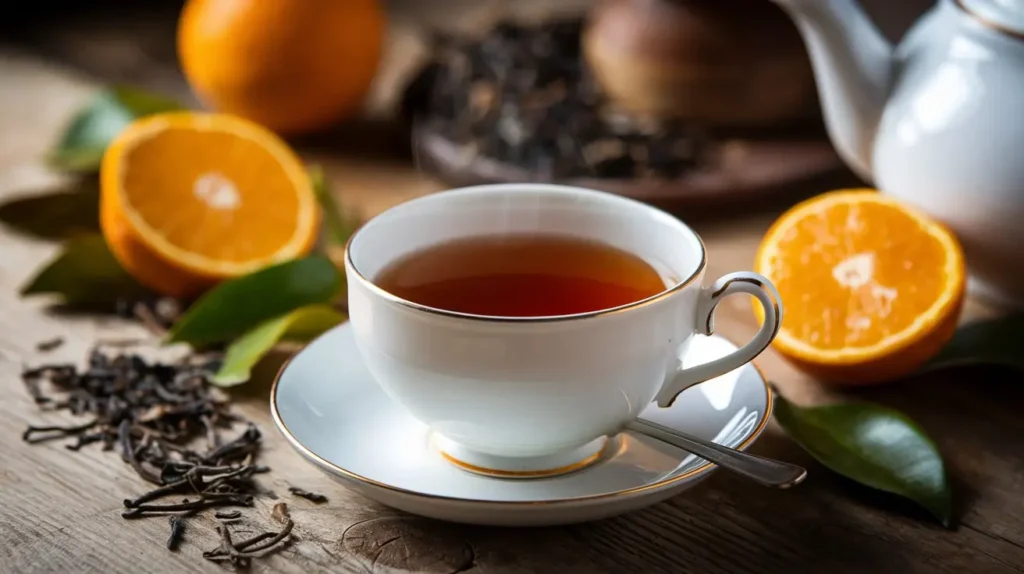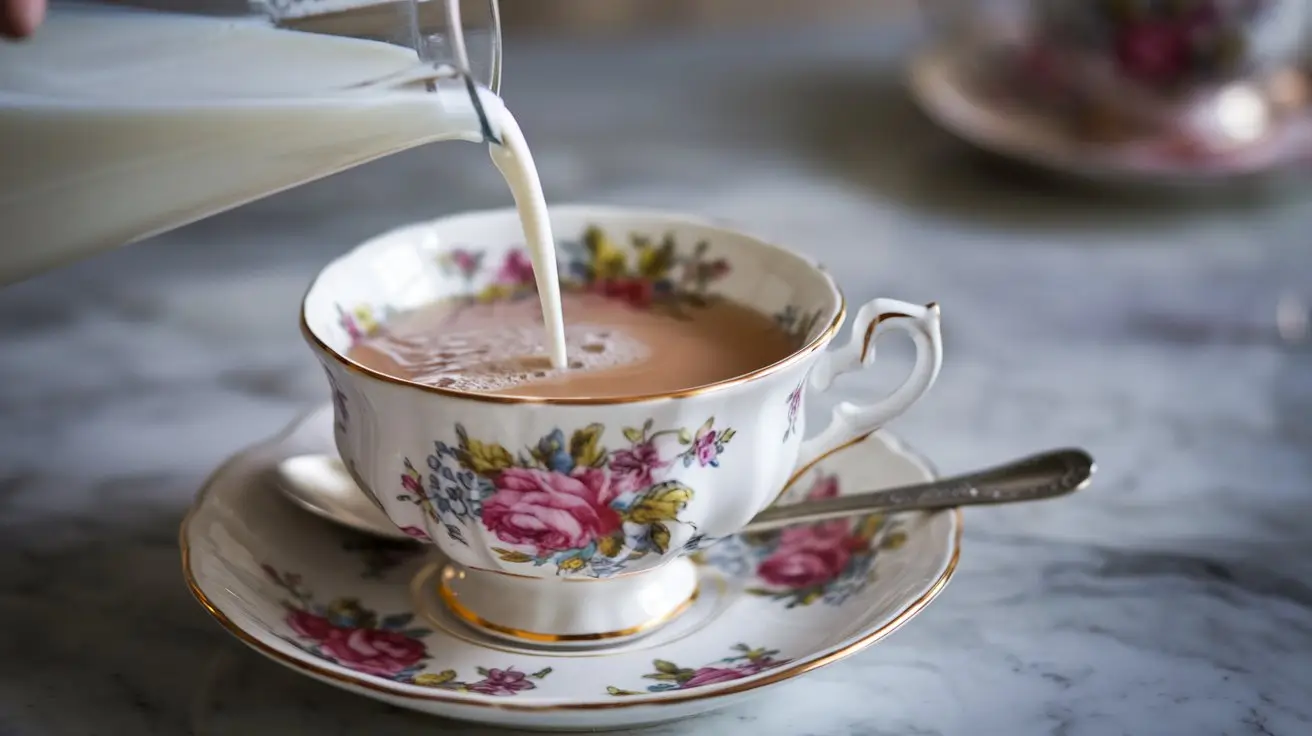Ah, Earl Grey tea, a classic, aromatic black tea infused with the distinctive essence of bergamot oil. It’s beloved by tea enthusiasts worldwide, but one burning question continues to divide tea drinkers: Do you put milk in Earl Grey?
Some say adding milk is a travesty that masks its delicate citrusy notes, while others argue that a splash of milk creates a smoother, creamier cup. But what’s the right way to enjoy it? Is there even a right way?
In this comprehensive guide, we’ll explore the history, flavor profile, and cultural perspectives on adding milk to Earl Grey tea. The debate over Do you put milk in Earl Grey? has divided tea lovers for years, and we’ll break down both sides to help you make an informed choice. We’ll also cover the best ways to prepare it, explore delicious variations like the London Fog, and answer some of the most frequently asked questions. Whether you’re a purist who enjoys the bold citrus notes or an adventurous drinker who prefers a creamier twist, this article will help you discover the perfect way to enjoy your cup of Earl Grey tea.
Now, let’s start with the basics!
Table of Contents
Understanding Earl Grey Tea
What is Earl Grey Tea?
Before we answer Do you put milk in Earl Grey?, let’s break down what makes this tea so special.

Earl Grey is a flavored black tea infused with bergamot oil, extracted from the rind of the bergamot orange, a citrus fruit that gives the tea its signature floral and slightly tangy taste. Traditionally made with black tea leaves, modern variations include green, white, and even rooibos versions.
Though its origins are debated, the most popular theory credits Charles Grey, 2nd Earl Grey, a British Prime Minister in the 1830s, for popularizing this tea. According to legend, a Chinese tea master created this blend to suit his refined taste, and it quickly became a staple in British households.
The Unique Flavor Profile of Earl Grey
Unlike plain black teas, Earl Grey offers a bold, slightly smoky base with a zesty, floral aroma. The bergamot adds a distinctive citrusy twist, making it a versatile tea that can be enjoyed plain, with lemon, honey, or even milk.
However, the citrus notes make it quite different from English Breakfast tea, which is typically served with milk. This is why many tea traditionalists believe that adding milk to Earl Grey dulls its natural brightness.
Why Bergamot Makes Earl Grey Different
So, why does bergamot oil matter when deciding whether or not to add milk?
- Bergamot has natural citrusy, floral notes, adding milk can mute these flavors.
- Some milk proteins interact with the citrus compounds, altering the taste.
- Certain brands use stronger black tea bases (like Assam), which pair better with milk, while others use lighter Darjeeling or Ceylon leaves, which shine best without it.
Understanding these characteristics is crucial to deciding whether milk belongs in your cup of Earl Grey. But what do tea experts and tea lovers say about it? Let’s dive into the debate!
The Debate – Should You Put Milk in Earl Grey?
The question Do you put milk in Earl Grey? has sparked debate among tea enthusiasts for years. Some claim that milk enhances the richness of the tea, while others argue that it dulls the bright, citrusy flavors. So, is there a correct answer? Let’s explore both sides of the argument.
The Traditional Approach: No Milk
Many tea purists indeed argue that Earl Grey tea should be enjoyed without milk, primarily due to the presence of bergamot oil. This leads to the common debate: Do you put milk in Earl Grey? While some enjoy the creamy texture, traditionalists believe milk interferes with the tea’s natural balance. Bergamot oil, extracted from the peel of Citrus bergamia, contains delicate citrus and floral aromatic compounds such as limonene, linalool, and linalyl acetate. These volatile constituents are responsible for Earl Grey’s distinctive fragrance and flavor profile. However, adding milk can mute or overshadow these defining citrus and floral notes, altering the intended aromatic experience. For those who prefer a more authentic taste, skipping the milk ensures that every sip highlights the bright, zesty character of Earl Grey tea. So, when asking Do you put milk in Earl Grey?, it ultimately comes down to whether you want to experience its full, unaltered flavor or enjoy a smoother, milky twist.
- Citrus and Dairy Don’t Always Mix – The acidity of bergamot can sometimes cause milk to curdle, creating an unpleasant texture.
- Lighter Tea Base – Unlike English Breakfast tea, which has a bold and malty flavor that pairs well with milk, Earl Grey often uses lighter Ceylon or Darjeeling tea leaves that shine best on their own.
- Aromatic Experience – Many tea drinkers believe that adding milk mutes the bright and fragrant aroma of Earl Grey.
Instead of milk, purists often prefer to enhance their tea with:
- A slice of lemon – This complements the bergamot oil rather than masking it.
- Honey or sugar – A small amount of sweetener can bring out the tea’s natural flavors.
The Modern Preference: Adding Milk
Despite traditional views, many people enjoy Earl Grey with a splash of milk. Some even argue that it creates a smoother, creamier experience.
- Stronger Tea Blends Work Well with Milk – If your Earl Grey is made with a robust black tea base like Assam or Keemun, milk can balance the boldness.
- London Fog Influence – The famous London Fog Latte, which blends Earl Grey, steamed milk, and vanilla syrup, has made the idea of milk in Earl Grey more mainstream.
- Personal Preference Matters – Ultimately, tea drinking is a personal experience. If adding milk makes it more enjoyable for you, why not?
How Milk Affects the Flavor of Earl Grey
Adding milk to Earl Grey alters its flavor profile in several ways:
- Softens the citrusy edge – Milk smooths out the brightness of bergamot, making the tea taste more mellow.
- Reduces bitterness – If steeped too long, black tea can become bitter. Milk helps balance this out.
- Adds creaminess – This makes the tea richer and more comforting, especially on cold days.
However, not all types of milk work well. Dairy milk, oat milk, and almond milk are popular choices, but coconut milk can sometimes clash with the bergamot oil.
Does Adding Milk Reduce Health Benefits?
Some studies suggest that adding milk to tea might reduce its antioxidant properties. The proteins in milk can bind to the catechins (natural antioxidants in tea), potentially lowering their absorption. However, the difference is small, and if you enjoy your Earl Grey with milk, it’s still a healthy choice.
So, should you put milk in Earl Grey? The answer depends on your taste preferences. If you love the bold citrus notes, enjoy it plain. If you prefer a smoother, creamier texture, go ahead and add milk!
The British Tea Culture and Earl Grey with Milk
Tea is deeply ingrained in British culture, but does that mean the British always add milk to Earl Grey? Let’s take a closer look at how this classic tea fits into British traditions.
Do the British Add Milk to Earl Grey?
The British are well-known for their love of tea, but Earl Grey is not typically served with milk in traditional settings. Unlike English Breakfast or builder’s tea, which are almost always enjoyed with milk, Earl Grey has a more delicate profile.
However, modern preferences have changed. Some British tea drinkers, especially those who prefer a milder taste, do add a splash of milk. The trend has grown even more popular with the rise of London Fog lattes and other creamy variations of Earl Grey.
Comparing Earl Grey to Other British Teas
In Britain, different types of black tea are enjoyed in different ways:
| Tea Type | Traditional Additions | Common Pairings |
|---|---|---|
| English Breakfast | Milk & sugar | Toast, biscuits |
| Earl Grey | Lemon or honey (traditionally) | Scones, pastries |
| Builder’s Tea | Always with milk & sugar | Full English breakfast |
As seen in the table, Earl Grey is one of the few black teas that is traditionally consumed without milk, though personal preferences vary.
Royal Influence: How the British Elite Enjoyed Earl Grey
Did you know that Earl Grey was once considered a tea for the British elite?
- It was named after Charles Grey, 2nd Earl Grey, who was Prime Minister of Britain in the 1830s.
- British high society enjoyed Earl Grey as a refined afternoon tea, often paired with delicate pastries and sandwiches.
- Queen Elizabeth II was known to drink tea with lemon, not milk, a habit many traditional tea lovers follow.
While traditionalists may avoid adding milk, tea culture continues to evolve. Today, whether you drink Earl Grey with or without milk depends entirely on your personal taste.
How to Properly Add Milk to Earl Grey
So, you’ve decided that you want to add milk to your Earl Grey tea. But how do you do it without ruining the delicate flavors? Whether you’re looking for a creamy twist or experimenting with new ways to enjoy your tea, following the right steps ensures a perfect cup every time.
Choosing the Right Type of Milk for Earl Grey
Not all milk works well with Earl Grey. Because of the tea’s citrusy bergamot flavor, some types of milk complement it better than others:
- Dairy Milk (Whole, Skim, or 2%) – Whole milk adds a rich, creamy texture, while skim milk keeps it light.
- Oat Milk – A popular non-dairy alternative that enhances the tea’s natural sweetness.
- Almond Milk – A mild option that won’t overpower the tea, but some brands may curdle when mixed with hot Earl Grey.
- Soy Milk – Creamy but has a stronger taste that may slightly alter the tea’s profile.
- Coconut Milk – Not always the best choice, as its tropical flavor can clash with bergamot oil.
To avoid curdling, warm the milk slightly before adding it to hot tea. Cold milk hitting a steaming cup of Earl Grey can cause unwanted separation.
The Best Brewing Method Before Adding Milk
For a balanced, flavorful cup of Earl Grey with milk, it’s essential to brew your tea correctly:
- Boil fresh water – Ideally, use filtered water heated to around 200°F (93°C).
- Steep your tea – Use one tea bag or 1 teaspoon of loose-leaf tea per cup. Let it steep for 3–5 minutes.
- Strain (if using loose-leaf tea) – Remove the tea leaves before adding anything.
- Add sweeteners first (optional) – If you like sugar or honey, add it before the milk for even mixing.
- Slowly pour in warm milk – Stir gently to blend without overpowering the flavors.
Step-by-Step Guide to Making the Perfect Earl Grey with Milk
- Heat 1 cup of water to the ideal temperature.
- Steep your Earl Grey tea bag or loose leaves for 3–5 minutes.
- Warm ¼ cup of milk separately to prevent curdling.
- Add a sweetener (optional) before pouring in the milk.
- Gently mix and enjoy!
If you want to take it a step further, try frothing your milk for a creamy, café-style tea experience. This technique is especially useful for making a London Fog Latte, which we’ll explore in the next section.
Popular Variations of Earl Grey with Milk
Adding milk to Earl Grey isn’t just about making a traditional cup of tea, it can also be the base for exciting and delicious variations. Here are some of the most popular ways to enjoy Earl Grey with milk.
London Fog: The Famous Earl Grey Latte
One of the most well-known ways to drink Earl Grey with milk is the London Fog Latte. This creamy, vanilla-infused drink has become a coffee shop favorite.
How to Make a London Fog Latte
You’ll need:
- 1 cup of strongly brewed Earl Grey tea
- ½ cup of steamed milk (oat or dairy works best)
- 1 teaspoon vanilla syrup
- Honey or sugar (optional)
Instructions:
- Brew a strong cup of Earl Grey tea and let it steep for 5 minutes.
- Heat and froth the milk.
- Stir in vanilla syrup and sweetener into the tea.
- Pour the frothed milk over the tea and enjoy!
Earl Grey Milk Tea: A Twist on Bubble Tea
For those who love bubble tea, Earl Grey Milk Tea is a must-try. This variation is inspired by Taiwanese milk teas but features the aromatic twist of bergamot.
How to Make Earl Grey Milk Tea
- Brew a strong Earl Grey tea base and let it cool.
- Mix in sweetened condensed milk or regular milk.
- Add cooked tapioca pearls for a fun texture.
- Serve over ice for a refreshing take!
Iced Earl Grey with Milk: A Refreshing Alternative
If you prefer cold drinks, an Iced Earl Grey with Milk is a great summer option. It combines the bold flavors of Earl Grey with the smoothness of milk in a chilled, refreshing drink.
Quick Recipe for Iced Earl Grey with Milk
- Brew Earl Grey and let it cool.
- Add ice cubes to a glass.
- Pour the tea over the ice and mix in milk.
- Stir well and enjoy!
Each of these variations showcases just how versatile Earl Grey tea can be. Whether you enjoy a classic cup or a fancy London Fog, the choice of adding milk is always up to you!
FAQs
The debate over Do you put milk in Earl Grey? has sparked curiosity among tea lovers. To clear up any confusion, here are answers to some of the most frequently asked questions about Earl Grey tea and milk.
Do you add milk to Earl Grey tea?
Yes, you can add milk to Earl Grey, but it depends on your personal preference. Traditionalists enjoy it without milk to preserve the bergamot flavor, while others prefer the creamy texture that milk adds. If you choose to add milk, opt for a strong Earl Grey blend, such as one with an Assam or Keemun base, to prevent the milk from overpowering the tea.
Is Earl Grey tea best without milk?
Many believe that Earl Grey is best enjoyed plain or with lemon because the citrus notes shine through. However, if you prefer a smoother, less acidic taste, adding milk can balance out the flavors. Some variations, like the London Fog Latte, are designed to be served with milk, making them just as popular as the traditional version.
Is Earl Grey meant to be drunk with milk?
Historically, Earl Grey was not intended to be served with milk. British tea culture typically pairs milk with English Breakfast or builder’s tea, while Earl Grey was often served with lemon or honey. However, tastes have evolved, and there’s no strict rule, so drink it how you like it!
Do the British put milk in their tea?
Yes, the British commonly add milk to black tea, especially English Breakfast and builder’s tea. However, Earl Grey is traditionally enjoyed without milk, though some Brits do add a splash for a smoother taste.

